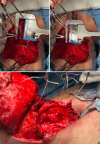Closure techniques for esophageal reconstruction after total laryngectomy and their impact on fistula formation
- PMID: 40741197
- PMCID: PMC12305097
- DOI: 10.5306/wjco.v16.i7.109246
Closure techniques for esophageal reconstruction after total laryngectomy and their impact on fistula formation
Abstract
Background: The rising incidence of laryngeal cancer has led to an increasing number of total laryngectomy procedures. While voice prostheses have significantly improved post-laryngectomy rehabilitation, the risk of salivary fistula remains a major complication. This study aims to compare the stapler and hand-sewn techniques for esophageal closure and evaluate their impact on fistula formation.
Aim: To compare stapler-assisted and hand-sewn esophageal closure techniques after laryngectomy regarding their impact on salivary fistula formation.
Methods: A total of 52 patients (44 men, 8 women), aged 43 to 77 years, underwent total laryngectomy. Esophageal reconstruction was performed using either a stapler (29 patients) or a hand-sewn technique (23 patients). A surgical stapler TA was used for esophageal closure in the stapler group. Patients were clinically monitored for fistula formation during the first 7 days postoperatively and again two weeks after discharge using fiberoptic examination.
Results: A total of 22 salivary fistulas were recorded: 17 (77.3%) occurred following the hand-sewn technique, while 5 (22.7%) developed in the stapler group. Additionally, preoperative radiotherapy was identified as a statistically significant risk factor for fistula formation. No technical complications related to the stapler device were observed.
Conclusion: Although hand-sewn closure is commonly used after total laryngectomy, stapler-assisted closure shows lower fistula rates and is a viable esophageal reconstruction alternative.
Keywords: Laryngeal cancer; Radiotherapy; Salivary fistula; Surgical stapler; Total laryngectomy.
©The Author(s) 2025. Published by Baishideng Publishing Group Inc. All rights reserved.
Conflict of interest statement
Conflict-of-interest statement: All the authors report no relevant conflicts of interest for this article.
Figures



Similar articles
-
Stapler versus scalpel resection followed by hand-sewn closure of the pancreatic remnant for distal pancreatectomy.Cochrane Database Syst Rev. 2015 Nov 6;2015(11):CD008688. doi: 10.1002/14651858.CD008688.pub2. Cochrane Database Syst Rev. 2015. Update in: Cochrane Database Syst Rev. 2025 Jun 10;6:CD008688. doi: 10.1002/14651858.CD008688.pub3. PMID: 26544925 Free PMC article. Updated.
-
Effectiveness of voice rehabilitation on vocalisation in postlaryngectomy patients: a systematic review.Int J Evid Based Healthc. 2010 Dec;8(4):256-8. doi: 10.1111/j.1744-1609.2010.00177.x. Int J Evid Based Healthc. 2010. PMID: 21091891
-
Stapler versus scalpel resection followed by handsewn closure of the pancreatic remnant for distal pancreatectomy.Cochrane Database Syst Rev. 2025 Jun 10;6(6):CD008688. doi: 10.1002/14651858.CD008688.pub3. Cochrane Database Syst Rev. 2025. PMID: 40492489 Review.
-
Incidence and Management of Pharyngo Cutaneous Fistula Following Total Laryngectomy - A Single Institutional 10 Years Experience.Indian J Otolaryngol Head Neck Surg. 2024 Oct;76(5):3967-3971. doi: 10.1007/s12070-024-04756-y. Epub 2024 May 24. Indian J Otolaryngol Head Neck Surg. 2024. PMID: 39376316
-
Does Augmenting Irradiated Autografts With Free Vascularized Fibula Graft in Patients With Bone Loss From a Malignant Tumor Achieve Union, Function, and Complication Rate Comparably to Patients Without Bone Loss and Augmentation When Reconstructing Intercalary Resections in the Lower Extremity?Clin Orthop Relat Res. 2025 Jun 26. doi: 10.1097/CORR.0000000000003599. Online ahead of print. Clin Orthop Relat Res. 2025. PMID: 40569278
References
-
- Cavaliere M, Bisogno A, Scarpa A, D'Urso A, Marra P, Colacurcio V, De Luca P, Ralli M, Cassandro E, Cassandro C. Biomarkers of laryngeal squamous cell carcinoma: a review. Ann Diagn Pathol. 2021;54:151787. - PubMed
-
- Korean Society of Thyroid-Head and Neck Surgery Guideline Task Force, Ahn SH, Hong HJ, Kwon SY, Kwon KH, Roh JL, Ryu J, Park JH, Baek SK, Lee GH, Lee SY, Lee JC, Chung MK, Joo YH, Ji YB, Hah JH, Kwon M, Park YM, Song CM, Shin SC, Ryu CH, Lee DY, Lee YC, Chang JW, Jeong HM, Cho JK, Cha W, Chun BJ, Choi IJ, Choi HG, Lee KD. Guidelines for the Surgical Management of Laryngeal Cancer: Korean Society of Thyroid-Head and Neck Surgery. Clin Exp Otorhinolaryngol. 2017;10:1–43. - PMC - PubMed
LinkOut - more resources
Full Text Sources

